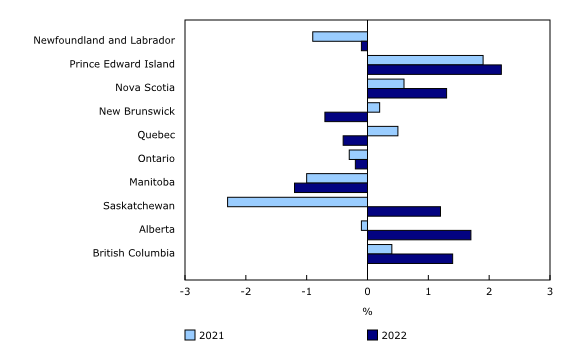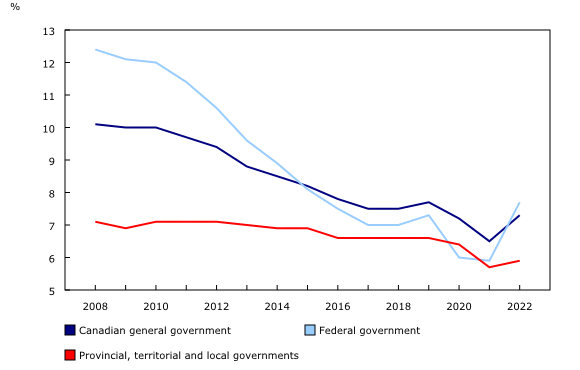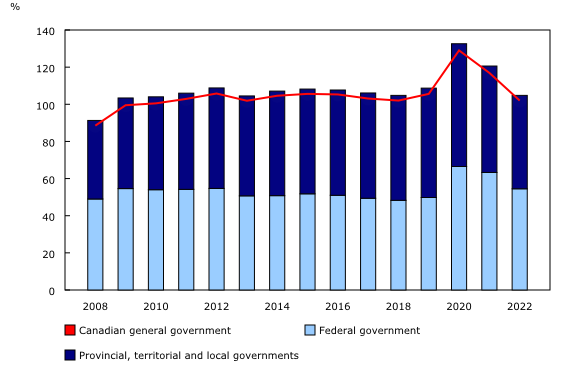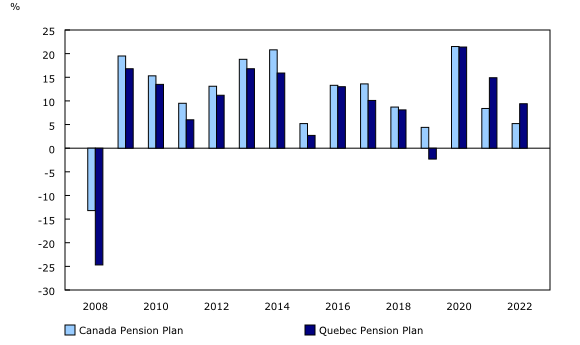Consolidated Canadian Government Finance Statistics, 2022
Released: 2023-11-22
Canadian general government deficit contracts due to increase in revenue
The consolidated Canadian general government (CGG) deficit, which includes federal, provincial, territorial and local governments, decreased from $63.7 billion in 2021 to $6.9 billion in 2022, down by $56.8 billion. This contraction is explained by an increase in revenues (+$58.2 billion or +5.9%), which offset a small increase in expenses (+$1.4 billion or +0.1%). The federal government recorded a deficit of $17.4 billion in 2022, down by $44.7 billion, while the consolidated provincial, territorial and local governments (PTLGs) recorded a surplus of $10.4 billion.
As a percentage of nominal gross domestic product (GDP), the CGG deficit fell to 0.2% in 2022 from 2.5% in 2021. Federal government deficit-to-GDP declined from 2.5% in 2021 to 0.6% in 2022, while PTLG recorded a surplus of 0.4% of GDP, the first surplus since 2008.
Downsized expenses lower federal government deficit
The federal government deficit contracted by $44.7 billion in 2022 as expenses declined by $33.3 billion (-7.0%), largely due to reductions in social benefits (-$28.9 billion) and subsidies (-$23.7 billion). These decreases were the result of the end of major COVID-19 assistance programs such as the Canada Emergency Wage Subsidy and Canada Recovery Benefit. Despite the overall decrease in federal government expenses, interest charges increased by $8.3 billion (+34.5%) in 2022. Old Age Security benefits also rose by $7.6 billion (+12.2%), partially due to the 10.0% permanent increase in benefits for seniors aged 75 years and older, implemented in July 2022.
Federal government revenue increased from $410.9 billion in 2021 to $422.4 billion (+2.8%) in 2022, mostly the result of a $10.8 billion (+15.6%) increase in taxes on goods and services compared with the previous year. Social contributions to employment insurance significantly increased in 2022 (+$2.3 billion or +9.6%), reflecting higher employment and wages compared with the previous year.
Rising oil and gas revenue contributed to the provincial, territorial and local governments surplus
In 2022, PTLG recorded a surplus of $10.4 billion, following a deficit of $1.6 billion in the previous year. This surplus was explained by a $43.5 billion increase in revenue that offset a $31.4 billion increase in expenses. Due to the surge in average oil and natural gas prices, the PTLG associated natural resource royalties rose from $18.9 billion in 2021 to $29.3 billion (+55.2%) in 2022, while corporate income tax went up by $13.9 billion (+27.0%) and taxes on goods and services increased by $12.6 billion (+9.5%).
Alberta recorded a surplus of $7.7 billion in 2022, mainly due to the increase in oil and gas royalties (+$8.9 billion). British Columbia also recorded a surplus ($5.5 billion), as did Saskatchewan ($1.3 billion), Nova Scotia ($0.7 billion) and Prince Edward Island ($0.2 billion). Meanwhile, Canada's two largest provinces recorded deficits in 2022: $2.0 billion in Quebec and $1.7 billion in Ontario.
As a percentage of GDP, the largest surplus in 2022 was recorded in Prince Edward Island (2.2%), followed by Alberta (1.7%), British Columbia (1.4%), Nova Scotia (1.3%) and Saskatchewan (1.2%). Meanwhile, Manitoba's deficit was the highest (1.2%) among the provinces as a percentage of GDP, followed by New Brunswick (0.7%) and Quebec (0.4%).
Higher policy interest rate pushes up government interest expenses
As a result of a 400-basis points increase in the policy interest rate from April 2022 to March 2023, CGG's interest expenses accrued on debt liabilities increased to $76.1 billion (+18.6%) in 2022 compared with $64.2 billion in 2021. The federal government spent $32.5 billion on interest in 2022, a significant increase of $8.3 billion (+34.5%) compared with 2021, while PTLG interest charges reached $43.8 billion (+9.0%). Federal government interest expenses were more impacted by the sharp increase in the policy interest rate, due to the federal government's significantly higher exposure to short term debt securities, such as Treasury bills.
The federal government's interest expense to revenue ratio increased by 1.8 percentage points to 7.7% in 2022, meaning that for every dollar of revenue, 7.7 cents was spent on interest expenses. The PTLG's ratio increased less, rising from 5.7% in 2021 to 5.9% in 2022.
Growth in gross domestic product reduces fiscal burden
Fiscal burden measures all taxes and social contributions paid to governments by individuals, businesses, and non-residents, expressed as a percentage of GDP. Canadian general government, Canada Pension Plan (CPP) and Quebec Pension Plan (QPP) taxes and social contributions totalled $968.2 billion in 2022, up from $908.9 billion in 2021 (+6.5%). Since nominal GDP growth (+11.8%) outpaced the increase in taxes and social contributions, fiscal burden expressed as a percentage of nominal GDP decreased from 36.1% in 2021 to 34.4% in 2022.
The federal government's fiscal burden decreased from 15.5% of GDP in 2021 to 14.3% of GDP in 2022, while PTLG's declined from 17.3% to 16.7% over that same period. PTLG fiscal burden was highest in Quebec (22.3%), followed by Nova Scotia (20.4%) and New Brunswick (18.1%), while Alberta posted by far the lowest fiscal burden (9.1%) among provinces, followed by Saskatchewan (14.2%).
Federal transfers to the provinces and territories decrease
Federal government transfers to the PTLGs went from $117.0 billion in 2021 to $113.5 billion in 2022, a decrease of 3.0%. Grants received by Ontario ($33.0 billion) and Quebec ($29.0 billion) represented 54.6% of the total federal grants to the PTLGs in 2022.
Among all provinces, Prince Edward Island received the highest grants per capita ($6,712), followed by New Brunswick ($5,289), and Nova Scotia ($4,872), while Ontario ($2,132), British Columbia ($2,180) and Alberta ($2,235) received the lowest.
Since the territories mostly rely on federal transfers as their primary source of revenue, they recorded significantly higher grants per capita than the provinces. In 2022, Nunavut recorded $60,275 in federal grants per capita, followed by the Northwest Territories ($45,056) and Yukon ($35,676).
Gross debt declines following downward market prices revaluation
In 2022, gross debt (total liabilities at market value) of CGG stood at $2,868.3 billion, down 2.5% from a year ago. Decreases in debt figures were mostly explained by the $94.0 billion downward market revaluation of liabilities in the form of debt securities, such as bills and bonds. Federal government gross debt totalled $1,532.3 billion (-3.8%), while PTLG gross debt decreased by 2.0% to $1,414.4 billion.
As a percentage of GDP, CGG gross debt fell from 116.9% in 2021 to 102.0% in 2022. Federal government gross debt-to-GDP was 54.5% in 2022, down from 63.3% the year before, while the PTLG ratio stood at 50.3% in 2022, down from 57.3%. Among all provinces, Quebec (81.4%) and Manitoba (80.8%) posted the highest gross debt-to-GDP ratios, while Alberta (28.6%) and British Columbia (31.9%) recorded the lowest.
Net debt decreases in all provinces
Net debt (gross debt minus financial assets) of the Canadian general government decreased by $80.8 billion to $1,356.0 billion in 2022. The federal government's net debt declined by $31.7 billion (-3.5%) and totalled $876.4 billion, while PTLGs' net debt decreased by $49.1 billion (-9.3%) to $479.6 billion.
Declines in net debt at market value were observed in all provinces and territories. British Columbia was the only province (since Alberta in 2016) to record a negative net debt (-$6.1 billion), partly due to a large surplus recorded in 2022. For the first time since 2015, the Northwest Territories joined Yukon and Nunavut to post a negative net debt. Debt in the territories is low compared with the provinces, since their borrowing capacity is restricted to limits set by the federal government.
Expressed as a percentage of GDP, CGG net debt decreased from 57.1% in 2021 to 48.2% in 2022. Federal government net debt-to-GDP ratio declined from 36.1% to 31.2% over that same period, while the PTLG ratio went down from 21.0% to 17.0%. The highest net debt-to-GDP ratio was recorded in Ontario at 25.9%, followed by Quebec (24.9%) and Manitoba (24.8%).
On a per capita basis, CGG net debt decreased from $37,143 in 2021 to $34,122 in 2022, a decrease exacerbated by the sharp rise in population (+2.7%). Federal government net debt per capita stood at $22,053 in 2022, down from $23,475 in 2021. Among provinces, Ontario recorded the highest net debt per capita at $17,598, followed by Newfoundland and Labrador ($17,509), Quebec ($15,422) and Manitoba ($14,877).
Growth in Quebec Pension Plan assets outpaces growth in Canada Pension Plan
The CPP and QPP are the largest social security funds in the country. Canadian workers' and employers' contributions to the CPP and QPP increased from $85.0 billion in 2021 to $98.3 billion in 2022 (+15.7%). On the other hand, social security benefit expenses, mostly retirement income, increased by $4.0 billion (+5.8%).
The net financial worth of the CPP and QPP reached $686.8 billion in 2022, a growth of 5.9% (+$38.3 billion). The CPP's net financial worth increased by 5.2%, outpaced by the 9.4% increase in the QPP's. The combined pension plans' net financial worth was 24.4% of GDP in 2022, down from 25.8% in 2021.
Net debt per capita and as a percentage of nominal gross domestic product (GDP), 2019 to 2022
Note to readers
This release includes revisions to both unconsolidated and consolidated Canadian Government Finance Statistics (CGFS) data for the 2020 and 2021 reference periods, as well as the addition of the 2022 reference period.
Annual data correspond to the end of the fiscal year closest to December 31. For example, data for the federal government fiscal year ending on March 31, 2023 (fiscal year 2022/2023), are reported for the 2022 reference year.
Preliminary CGFS data are published eight months after the end of the fiscal year; therefore, estimates were prepared before several public accounts and financial statements were audited and published by government entities.
CGFS data differ from reports published by governments due to differences in institutional coverage, accounting rules, timing and integration with the Canadian macroeconomic accounts.
Consolidation is a method of presenting one overarching statistic for a set of units. It involves eliminating all transactions and debtor–creditor relationships among the units being consolidated. In other words, the transaction of one unit is paired with the same transaction as recorded for the second unit and both transactions are eliminated.
In 2022, the consolidation method removed $217.8 billion in internal revenues and expenses, as well as $211.0 billion related to internal debtor–creditor relationships for the Canadian General Government (CGG).
Consolidated data are released for the CGG, which combines federal government data with provincial–territorial and local government (PTLG) data, but excludes data for the Canada Pension Plan and Quebec Pension Plan.
Consolidated data are also released for the PTLGs, which include provincial and territorial governments, health and social service institutions, universities and colleges, municipalities and other local public administrations, and school boards.
The constitutional framework of PTLGs in the territories differs from that in the provinces, leading to differences in the roles and financial authorities of government. These differences, as well as other geographic, demographic, and socioeconomic dissimilarities between the North and the rest of Canada, give rise to marked disparities in government finance statistics.
PTLG data can be compared across provinces and territories because consolidation considers differences in administrative structure and government service delivery by removing the effects of internal public sector transactions within each jurisdiction.
Because PTLG finance statistics vary significantly across jurisdictions in Canada due to size differences, per capita data are used to facilitate comparisons. Per capita data are based on population estimates as of April 1 for Canada, the provinces and the territories, available in Table 17-10-0009-01.
Calculations as a percentage of nominal gross domestic product (GDP) are based on the nominal GDP at market prices, expenditure-based, estimates for Canada, the provinces and the territories, available in Table 36-10-0222-01.
In this release, revenues, expenses, assets, and liabilities are reported in nominal terms.
The net operating balance is the difference between revenues and expenses for a given period and is a summary measure of the sustainability of government operations. When revenues are lower than expenses, a deficit is recorded, while the reverse induces a surplus.
Net financial worth is defined as the total value of financial assets minus the total value of liabilities. When liabilities are greater than financial assets the measure is referred to as net debt as per public accounts. Net debt gives a more comprehensive view of the financial position of the government and is used as a key indicator to assess the sustainability of fiscal policy.
Products
The Canadian Government Finance Statistics 2014 classification structure is now available in the Definitions, data sources and methods module of our website.
Additional information can be found in the Latest Developments in the Canadian Economic Accounts (13-605-X). The User Guide: Canadian System of Macroeconomic Accounts (13-606-G) is also available. This publication has been updated with Chapter 9. Government Finance Statistics.
Contact information
For more information, or to enquire about the concepts, methods or data quality of this release, contact us (toll-free 1-800-263-1136; 514-283-8300; infostats@statcan.gc.ca) or Media Relations (statcan.mediahotline-ligneinfomedias.statcan@statcan.gc.ca).
- Date modified:






